Application of Image Analysis for the Identification of Prehistoric Ceramic Production Technologies in the North Caucasus (Russia, Bronze/Iron Age)
Abstract
:1. Introduction
2. Materials and Methods
2.1. Archaeological Sites
2.2. Materials
2.3. Image Acquisition and Reconstruction
2.3.1. Sand Grains in the Ceramics
2.3.2. Pore Topology in the Ceramics
2.3.3. Formation of the Ceramics
2.4. Image Segmentation and Parameterization
3. Results and Discussion
3.1. Characterization of Ceramic Pastes by Shape Parameters of Sand Grains
3.2. Pore Topology and Pyrometamorphic Degree
3.3. Shaping Techniques: Inner Structure
4. Conclusions
Supplementary Materials
Author Contributions
Funding
Acknowledgments
Conflicts of Interest
References
- Cnudde, V.; Boone, M.N. High-resolution X-ray computed tomography in geosciences: A review of the current technology and applications. Earth-Sci. Rev. 2013, 123, 1–17. [Google Scholar] [CrossRef] [Green Version]
- Ketcham, R.A.; Carlson, W.D. Acquisition, optimization and interpretation of X-ray computed tomographic imagery: Applications to the geosciences. Comput. Geosci. 2001, 27, 381–400. [Google Scholar] [CrossRef]
- Dierick, M.; Cnudde, V.; Masschaele, B.; Vlassenbroeck, J.; Van Hoorebeke, L.; Jacobs, P. Micro-CT of fossils preserved in amber. Nucl. Instrum. Methods Phys. Res. 2007, 580, 641–643. [Google Scholar] [CrossRef]
- Selden, P.A.; Penney, D. Imaging techniques in the study of fossil spiders. Earth-Sci. Rev. 2017, 166, 111–131. [Google Scholar] [CrossRef] [Green Version]
- Voltolini, M.; Zandomeneghi, D.; Mancini, L.; Polacci, M. Texture analysis of volcanic rock samples: Quantitative study of crystals and vesicles shape preferred orientation from X-ray microtomography data. J. Volcanol. Geotherm. Res. 2011, 202, 83–95. [Google Scholar] [CrossRef]
- Bauer, B.; Cai, X.; Peth, S.; Schladitz, K.; Steidl, G. Variational-based segmentation of bio-pores in tomographic images. Comput. Geosci. 2017, 98, 1–8. [Google Scholar] [CrossRef]
- Brun, F.; Mancini, L.; Kasae, P.; Favretto, S.; Dreossi, D.; Tromba, G. Pore3D: A software library for quantitative analysis of porous media. Nucl. Instrum. Methods Phys. Res. 2010, 615, 326–332. [Google Scholar] [CrossRef]
- Yin, X.-Z.; Wu, L.; Li, Y.; Guo, T.; Li, H.-Y.; Xiao, T.-Q.; York, P.; Nangia, A.; Gui, S.-Y.; Zhang, J.-W. Visualization and quantification of deformation behavior of clopidogrel bisulfate polymorphs during tableting. Sci. Rep. 2016, 6, 21770. [Google Scholar] [CrossRef] [PubMed]
- Lindahl, A.; Pikirayi, I. Ceramics and change: An overview of pottery production techniques in northern South Africa and eastern Zimbabwe during the first and second millennium AD. Archaeol. Anthr. Sci. 2010, 2, 133–149. [Google Scholar] [CrossRef]
- Morzadec, H. Petro-archeologie des ceramiques armoricaines du neolithique a la fin de l’age du fer. Thèse de doctorat en Archéologie et archéométrie, Université de Rennes, Rennes, France, 1993. [Google Scholar]
- Quinn, P.S.; Burton, M.M.; Broughton, D.; van Heymbeeck, S. Deciphering compositional patterning in plain ware ceramics from late prehistoric hunter-gatherer sites in the peninsular ranges, San Diego county, California. Am. Antiq. 2013, 78, 779–789. [Google Scholar] [CrossRef]
- Quinn, P.S.; Burton, M.M. Ceramic distribution, migration and cultural interaction among late prehistoric (ca. 1300–200 B.P.) hunter-gatherers in the San Diego region, Southern California. J. Archaeol. Sci. Rep. 2016, 5, 285–295. [Google Scholar] [CrossRef]
- Sobott, R.; Bente, K.; Kittel, M. Comparative porosity measurements on ceramic materials. Old Potter’s Alm. 2014, 19, 18–25. [Google Scholar] [CrossRef]
- Reedy, C.L.; Anderson, J.; Reedy, T.J.; Liu, Y. Image Analysis in Quantitative Particle Studies of Archaeological Ceramic Thin Sections. Adv. Archaeol. Pract. 2014, 2, 252–268. [Google Scholar] [CrossRef] [Green Version]
- Livingood, P.C.; Cordell, A.S. Point/counter point: The accuracy and feasibility of digital image techniques in the analysis of ceramic thin sections. J. Archaeol. Sci. 2009, 36, 867–872. [Google Scholar] [CrossRef]
- Courty, M.; Roux, V. Identification of wheel throwing on the basis of ceramic surface features and microfabrics. J. Archaeol. Sci. 1995, 22, 17–50. [Google Scholar] [CrossRef] [Green Version]
- Roux, V.; Courty, M.A. Identification of wheel-fashioning methods: Technological analysis of 4th-3rd Millennium BC oriental ceramics. J. Archaeol. Sci. 1998, 25, 747–763. [Google Scholar] [CrossRef]
- Carr, C. Advances in ceramic radiography and analysis: Applications and potentials. J. Archaeol. Sci. 1990, 17, 13–34. [Google Scholar] [CrossRef]
- Kozatsas, J.; Kotsakis, K.; Sagris, D.; David, K. Inside out: Assessing pottery forming techniques with micro-CT scanning. An example from Middle Neolithic Thessaly. J. Archaeol. Sci. 2018, 100, 102–119. [Google Scholar] [CrossRef]
- Gomart, L.; Weiner, A.; Gabriele, M.; Durrenmath, G.; Sorin, S.; Angeli, L.; Colombo, M.; Fabbri, C.; Maggi, R.; Panelli, C.; et al. Spiralled patchwork in pottery manufacture and the introduction of farming to Southern Europe. Antiquity 2017, 91, 1501–1514. [Google Scholar] [CrossRef]
- Berg, I. Looking through pots: Recent advances in ceramics X-radiography. J. Archaeol. Sci. 2008, 35, 1177–1188. [Google Scholar] [CrossRef]
- Kahl, W.-A.; Ramminger, B. Non-destructive fabric analysis of prehistoric pottery using high-resolution X-ray microtomography: A pilot study on the late Mesolithic to Neolithic site Hamburg-Boberg. J. Archaeol. Sci. 2012, 39, 2206–2219. [Google Scholar] [CrossRef]
- Cultrone, G.; Sebastián, E.; Elert, K.; de la Torre, M.J.; Cazalla, O.; Rodriguez-Navarro, C. Influence of mineralogy and firing temperature on the porosity of bricks. J. Eur. Ceram. Soc. 2004, 24, 547–564. [Google Scholar] [CrossRef]
- Rathossi, C.; Pontikes, Y. Effect of firing temperature and atmosphere on ceramics made of NW Peloponnese clay sediments: Part II. Chemistry of pyrometamorphic minerals and comparison with ancient ceramics. J. Eur. Ceram. Soc. 2010, 30, 1853–1866. [Google Scholar] [CrossRef]
- Diamond, S. Physical and chemical characteristics of cement composites. In Durability of Concrete and Cement Composites; Page, C.L., Page, M.M., Eds.; Woodhead Publishing: Cambridge, UK, 2007; pp. 10–44. [Google Scholar]
- Sevinç, I.; Sarikaya, Y.; Akinc, M.; Sarıkaya, Y. Adsorption characteristics of alumina powders produced by emulsion evaporation. Ceram. Int. 1991, 17, 1–4. [Google Scholar] [CrossRef]
- Velde, B.; Druc, I.C. Archaeological Ceramic Materials; Springer: Berlin/Heidelberg, Germany, 1999. [Google Scholar]
- Velde, B. Use of image analysis in determining multi-source ceramic materials. In Pottery Manufacturing Processes: Reconstitution and Interpretation; Smith, A.L., Bosquet, D., Martineau, R., Eds.; Archaeopress: Oxford, UK, 2005; pp. 95–99. [Google Scholar]
- Whitbread, I.K. Image and data processing in ceramic petrology. In Recent Developments in Ceramic Petrology; British Museum Occasional Paper 81; Middleton, A., Freestone, I., Eds.; British Museum Press: London, UK, 1991; pp. 369–388. [Google Scholar]
- Albero Santacreu, D.J.; Cau Ontiveros, M.Á. Technological Choices in Hand-Made Indigenous Pottery from Western Mallorca (Balearic Islands, Spain) (C.1200–75 bc): An archaeometric approach. Archaeometry 2017, 59, 642–666. [Google Scholar] [CrossRef]
- Lechtman, H. Style in technology: Some early thoughts. In Material Culture: Style, Organization and Dynamics of Technology; Lechtman, H., Merrill, R.S., Eds.; West Publishing Company: St. Paul, MN, USA, 1977; pp. 3–20. [Google Scholar]
- Pfaffenberger, B. Social anthropology of technology. Annu. Rev. Anthropol. 1992, 21, 491–516. [Google Scholar] [CrossRef]
- Gosselain, O.P. Social and technical identity in a clay crystal ball. In The Archaeology of Social Boundaries; Stark, M.T., Ed.; Smithsonian Institution Scholarly Press: Washington, DC, USA; London, UK, 1998; pp. 78–106. [Google Scholar]
- Albero Santacreu, D. Materiality, Techniques and Society in Pottery Production; De Gruyter: Berlin, Germany, 2014. [Google Scholar] [CrossRef]
- Park, K.S.; Milke, R.; Efthimiopoulos, I.; Pausewein, R.R.; Reinhold, S. Pyrometamorphic process of ceramic composite materials in the pottery production in the Bronze/Iron Age of the Northern Caucasus. Sci. Rep. 2019, 9, 10725. [Google Scholar] [CrossRef]
- Reinhold, S.; Korobov, D.S.; Belinskij, A.B. Landschaftsarchäologie im Nordkaukasus; Habelt. R.: Bonn, Germany, 2018. [Google Scholar]
- Dally, O.; van Hoof, L.; Huy, S.; Il´jaschenko, S.; Larenok, P.A.; Larenok, V.A.; Schlöffel, M.; Schunke, T.; Schütt, B. Deutsch-russische Ausgrabungen am Don. Ergebnisse der Kampagnen 2008–2010. Archäologischer Anzeiger 2012, 1, 139–205. [Google Scholar]
- Zähle, M. A Kinematic Formula and Moment Measures of Random Sets. Math. Nachrichten 1990, 149, 325–340. [Google Scholar] [CrossRef]
- Wadell, H. Volume, shape, and roundness of quartz particles. J. Geol. 1932, 43, 250–280. [Google Scholar] [CrossRef]
- Barrett, P.J. The shape of rock particles, a critical review. Sedimentol. 1980, 27, 291–303. [Google Scholar] [CrossRef]
- Krumbein, W.C. The Effects of Abrasion on the Size, Shape and Roundness of Rock Fragments. J. Geol. 1941, 49, 482–520. [Google Scholar] [CrossRef]
- Park, K.S.; Milke, R.; Reinhold, S. Technological styles in the daily ware production in the semi-sedentary society (North Caucasus (Russia), The Bronze/Iron Age). In Proceedings of the International Workshop, ‘Approaches in the Analysis of Production at Archaeological Sites’, Berlin, Germany, 20–21 January 2018; Hodgkinson, A.K., Tvetmarken, C.L., Eds.; Archaeopress: Oxford, UK, 2019. (in press) [Google Scholar]
- Fabbri, F.; Gualtieri, S.; Shoval, S. The presence of calcite in archaeological ceramics. J. Eur. Ceram. Soc. 2014, 34, 1899–1911. [Google Scholar] [CrossRef]
- Nodari, L.; Marcuz, E.; Maritan, L.; Mazzoli, C.; Russo, U. Hematite nucleation and growth in the firing of carbonate-rich clay for pottery production. J. Eur. Ceram. Soc. 2007, 27, 4665–4673. [Google Scholar] [CrossRef]
- Okuma, G.; Kadowaki, D.; Hondo, T.; Tanaka, S.; Wakai, F. Interface topology for distinguishing stages of sintering. Sci. Rep. 2017, 7, 11106. [Google Scholar] [CrossRef] [PubMed]
- Coble, R.L. Sintering Crystalline Solids. I. Intermediate and Final State Diffusion Models. J. Appl. Phys. 1961, 32, 787–792. [Google Scholar] [CrossRef]
- De Jonghe, L.C.; Rahaman, M.N. Sintering of Ceramics. In Handbook of Advanced Ceramics: Materials, Applications, Processing and Properties; Sōmiya, S., Ed.; Elsevier Inc.: Waltham, MA, USA; Oxford, UK; Amsterdam, The Netherlands, 2003; Volume 1–2, pp. 187–264. [Google Scholar] [CrossRef]
- Ferrer, S.; Mezquita, A.; Gómez-Tena, M.P.; Machí, C.; Monfort, E. Estimation of the heat of reaction in traditional ceramic compositions. Appl. Clay Sci. 2015, 108, 28–39. [Google Scholar] [CrossRef] [Green Version]
- Vogel, H. Morphological determination of pore connectivity as a function of pore size using serial sections. Eur. J. Soil Sci. 1997, 48, 365–377. [Google Scholar] [CrossRef]
- Vogel, H.-J.; Weller, U.; Schlüter, S. Quantification of soil structure based on Minkowski functions. Comput. Geosci. 2010, 36, 1236–1245. [Google Scholar] [CrossRef]
- Vogel, H.-J.; Roth, K. Quantitative morphology and network representation of soil pore structure. Adv. Water Resour. 2001, 24, 233–242. [Google Scholar] [CrossRef]
- Legland, D.; Kiêu, K.; Devaux, M.F. Computation of Minkowski measures on 2D and 3D binary images. Image Anal. Stereol. 2007, 26, 83–92. [Google Scholar] [CrossRef]
- Lehmann, G.; Legland, D. Efficient N-Dimensional surface estimation using Crofton formula and run-length encoding. Insight J. 2012. Available online: https://hdl.handle.net/10380/3342 (accessed on 15 October 2018).
- Shoemake, K. III.5.—Euler Angle Conversion. In Graphics Gems; Heckbert, P.S., Ed.; Elsevier Inc.: London, UK, 1994; Volume IV, pp. 222–229. [Google Scholar] [CrossRef]
- Pavanati, H.C.; Maliska, A.M.; Klein, A.N.; Muzart, J.L.R. Comparative study of porosity and pores morphology of unalloyed iron sintered in furnace and plasma reactor. Mat. Res. 2007, 10, 87–93. [Google Scholar] [CrossRef] [Green Version]
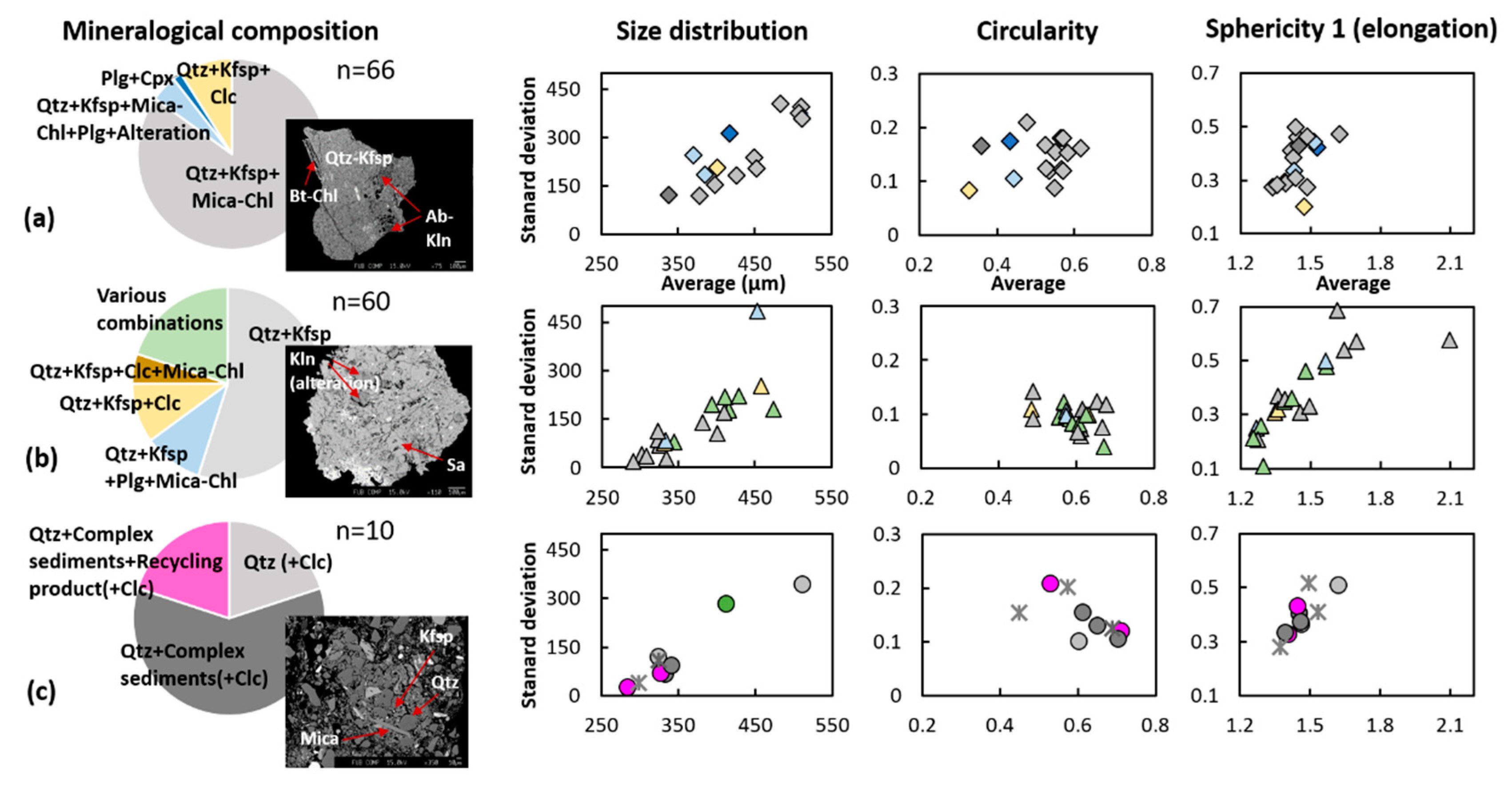

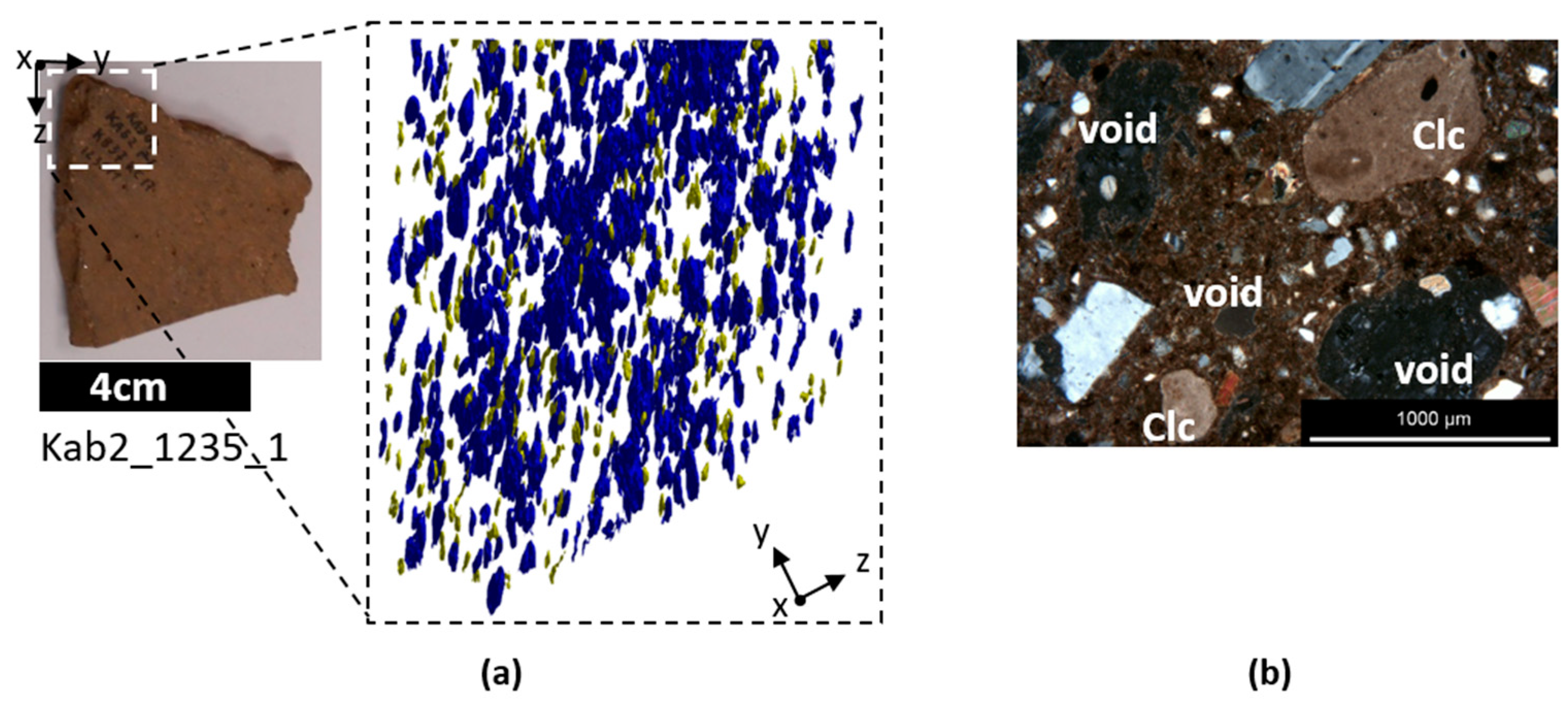
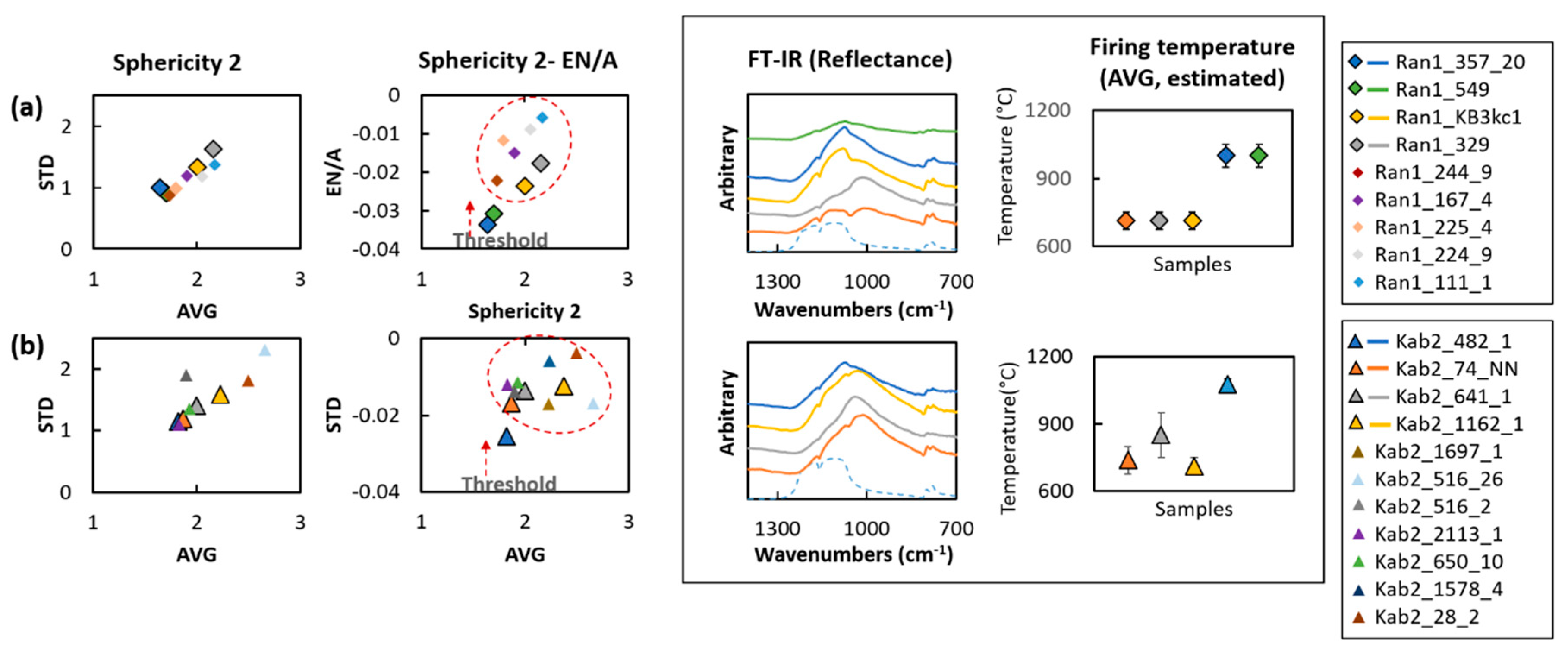
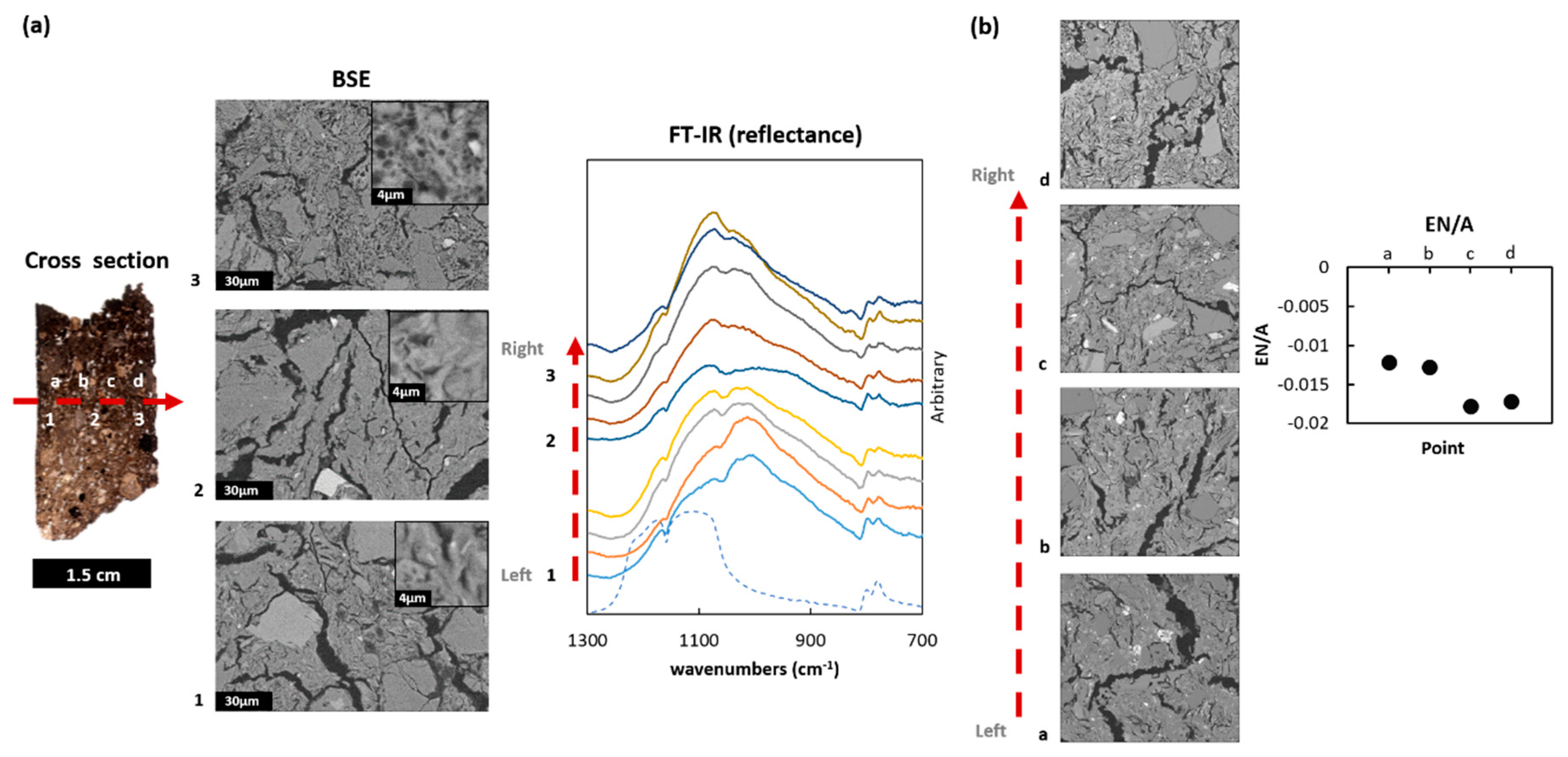
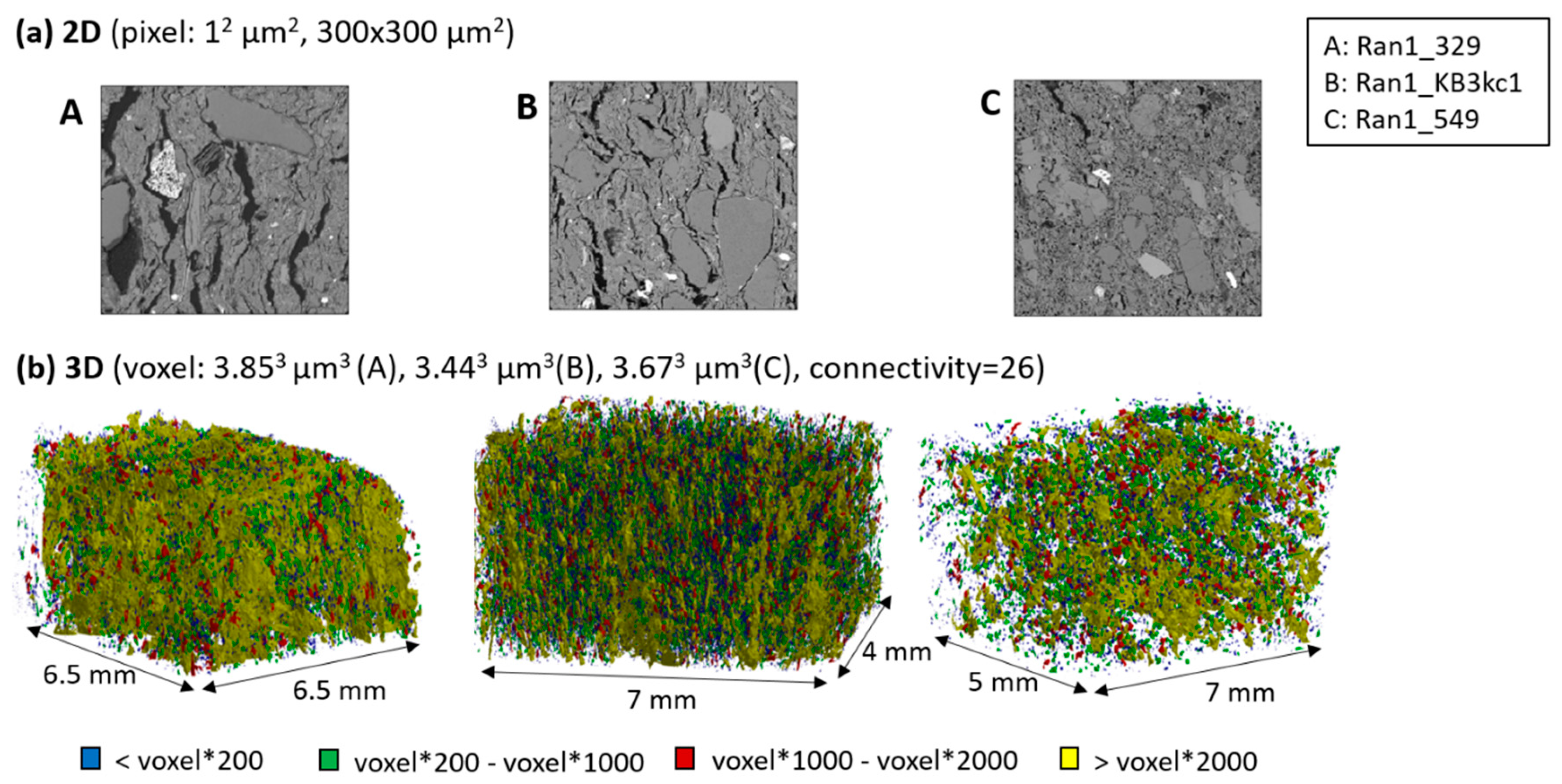
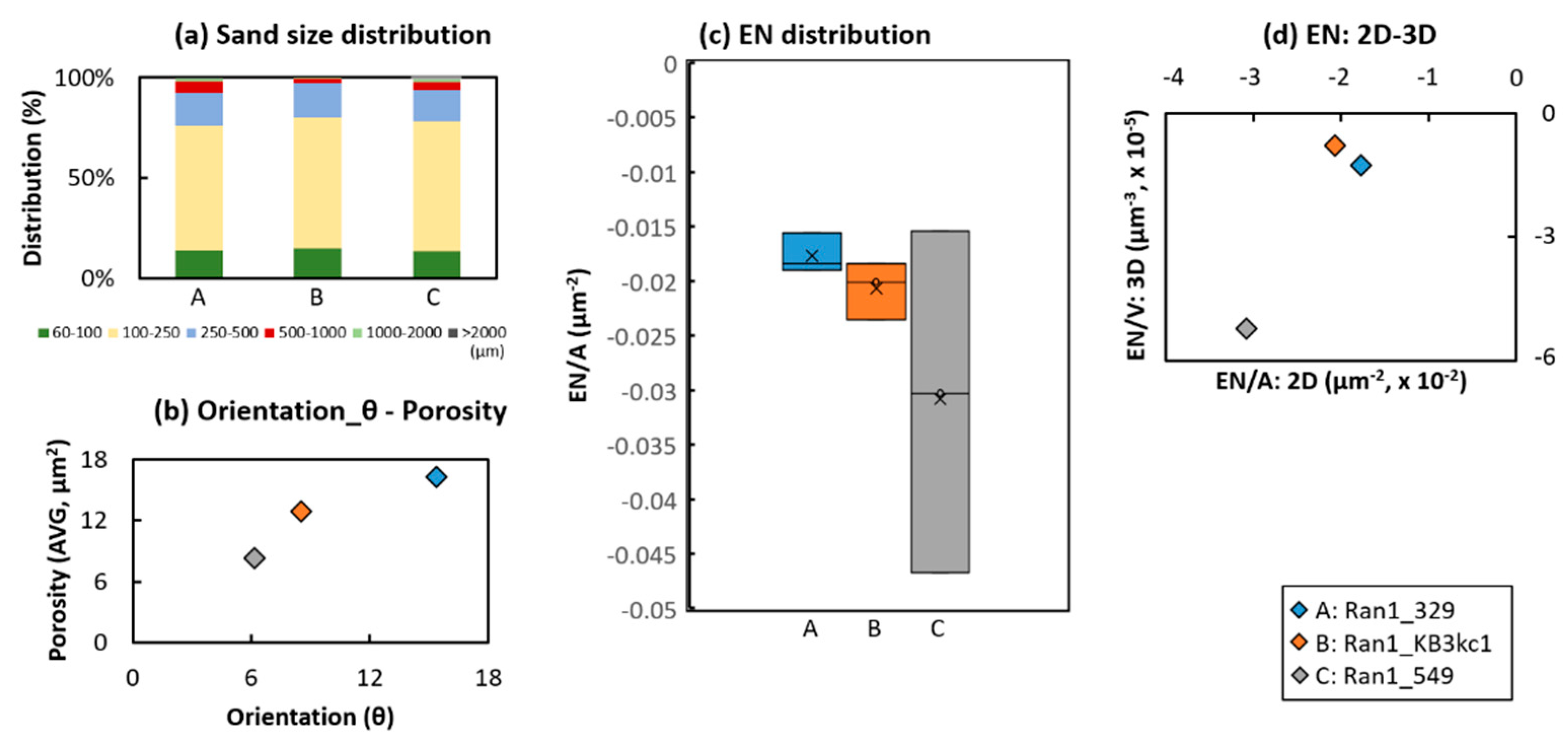
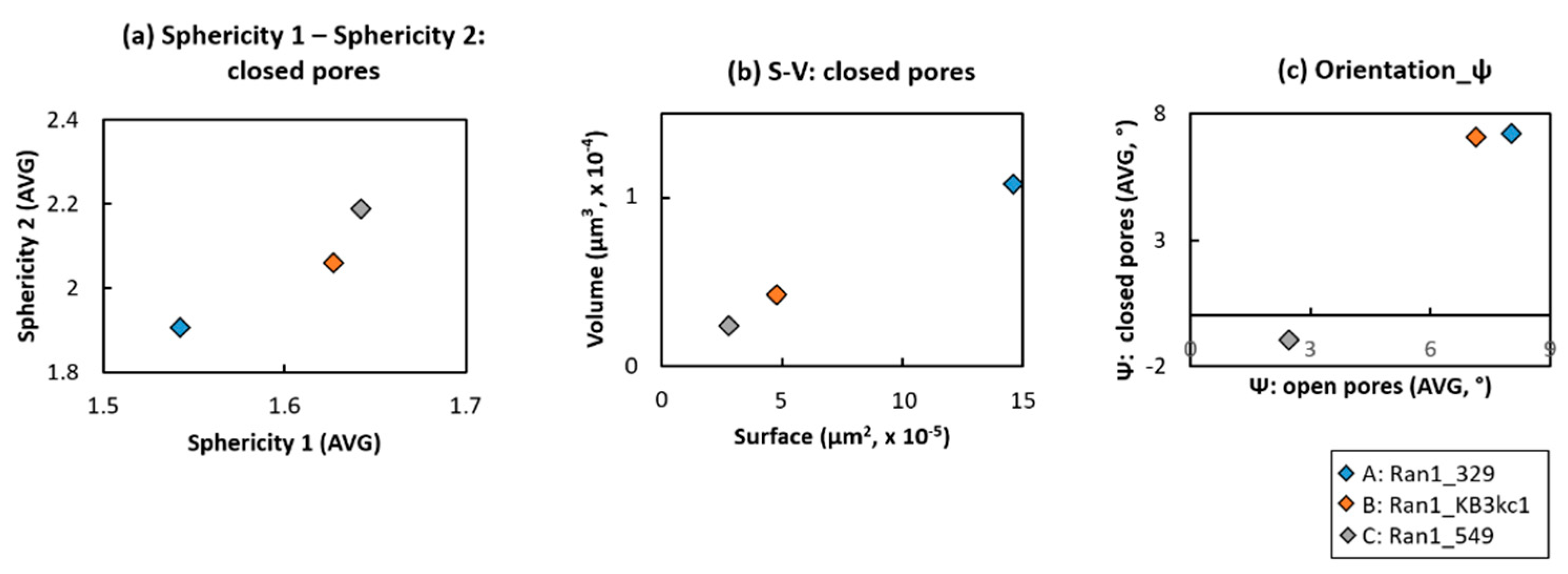
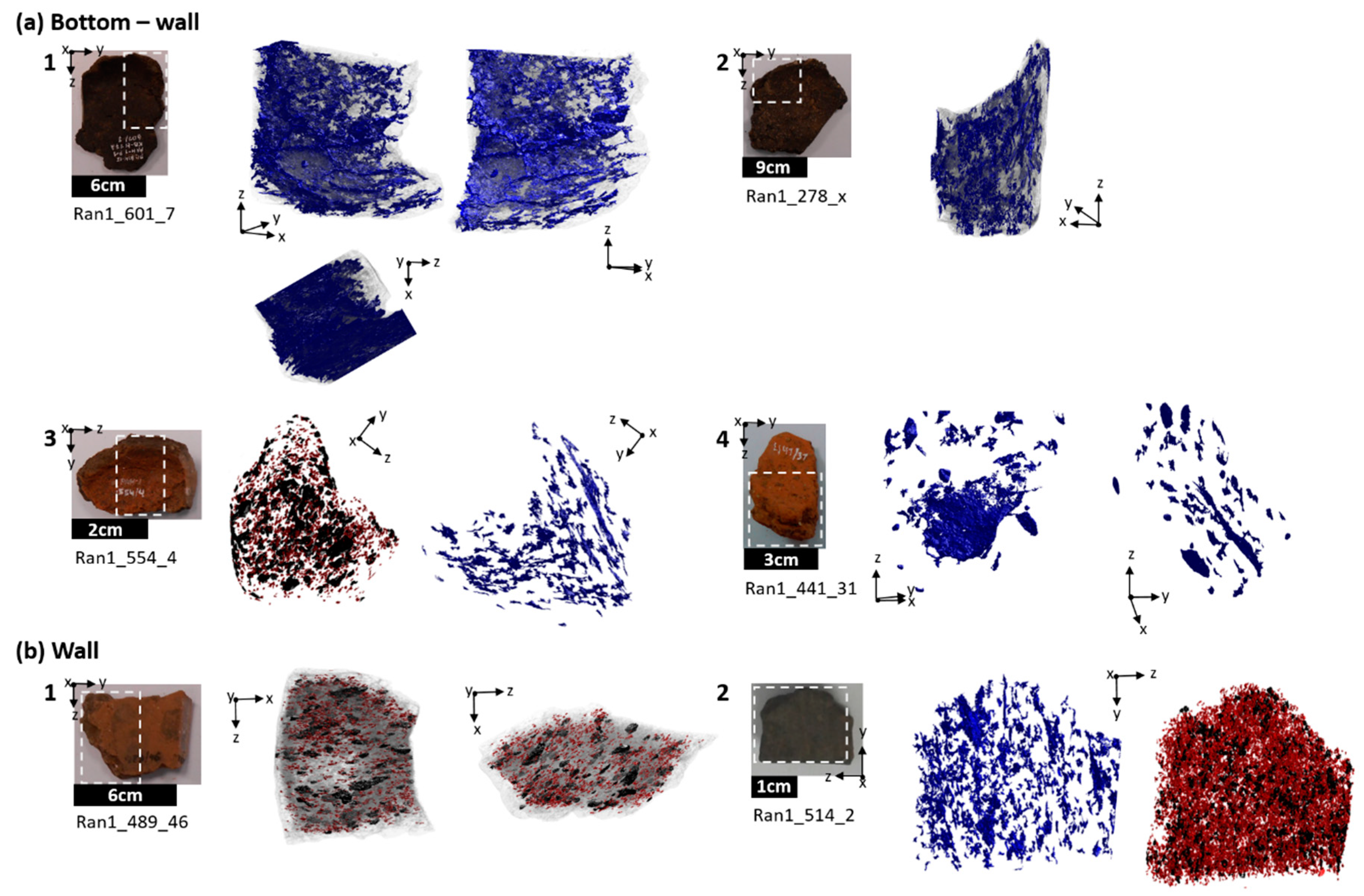
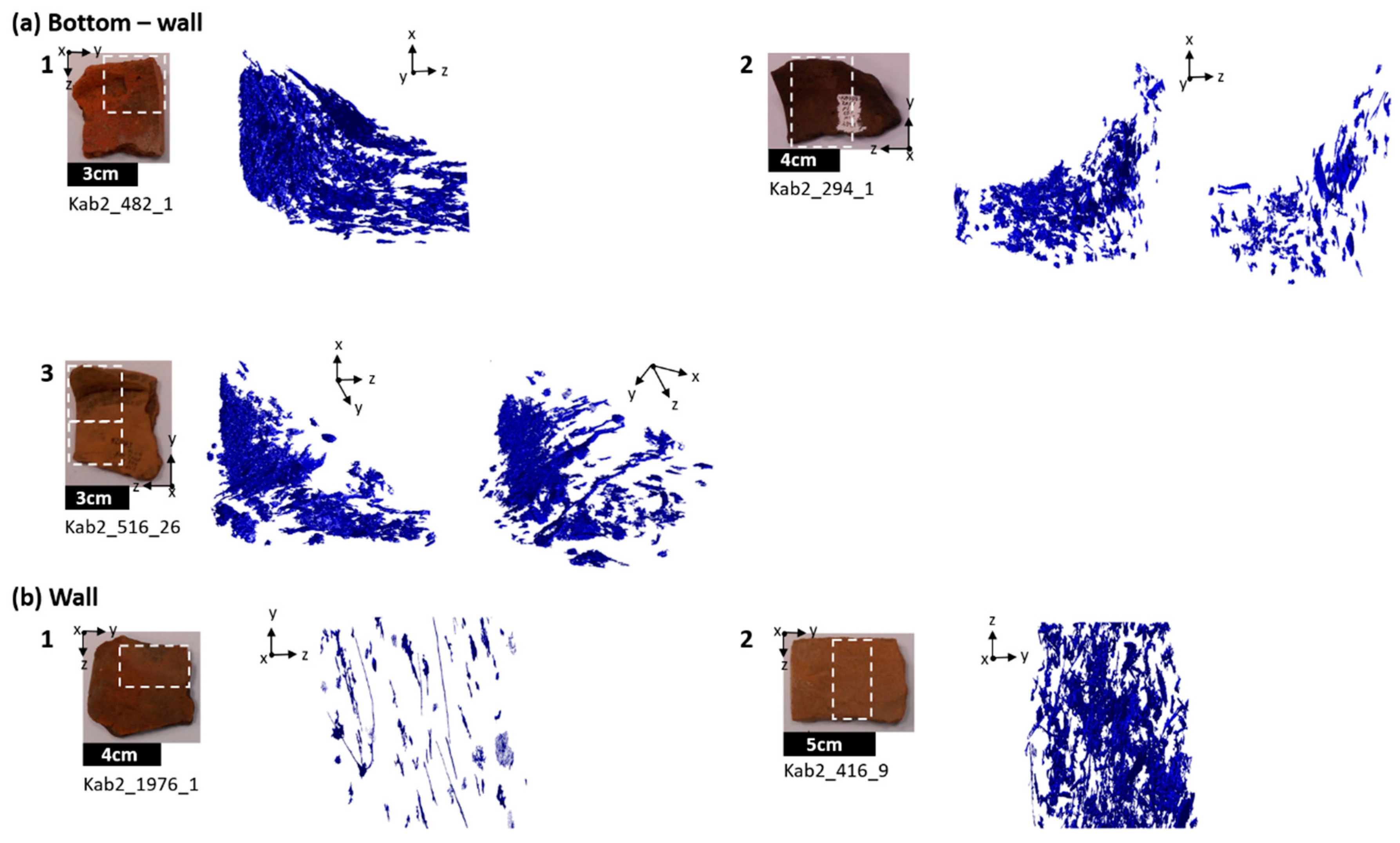
© 2019 by the authors. Licensee MDPI, Basel, Switzerland. This article is an open access article distributed under the terms and conditions of the Creative Commons Attribution (CC BY) license (http://creativecommons.org/licenses/by/4.0/).
Share and Cite
Park, K.S.; Milke, R.; Rybacki, E.; Reinhold, S. Application of Image Analysis for the Identification of Prehistoric Ceramic Production Technologies in the North Caucasus (Russia, Bronze/Iron Age). Heritage 2019, 2, 2327-2342. https://doi.org/10.3390/heritage2030143
Park KS, Milke R, Rybacki E, Reinhold S. Application of Image Analysis for the Identification of Prehistoric Ceramic Production Technologies in the North Caucasus (Russia, Bronze/Iron Age). Heritage. 2019; 2(3):2327-2342. https://doi.org/10.3390/heritage2030143
Chicago/Turabian StylePark, Ki Suk, Ralf Milke, Erik Rybacki, and Sabine Reinhold. 2019. "Application of Image Analysis for the Identification of Prehistoric Ceramic Production Technologies in the North Caucasus (Russia, Bronze/Iron Age)" Heritage 2, no. 3: 2327-2342. https://doi.org/10.3390/heritage2030143




